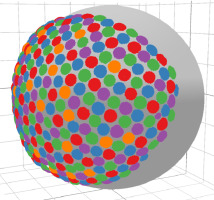Pattern Recognition Letters ( IF 3.9 ) Pub Date : 2020-02-10 , DOI: 10.1016/j.patrec.2020.02.012 Cesar H. Comin , Gavin J. Taylor , Luciano da F. Costa

|
Several natural and artificial structures, such as human skin and mammals cortices, exhibit a compound organization, with basic elements being distributed along a surface. The problem of quantifying the geometrical uniformity of this type of biological and physical compound structures is addressed in this work. This required the solution of several problems, including the detection, along the surface, of the borders of the compound system, defining the adjacency between the elements in the 3D space, and obtaining a reference of uniformity for calculating the polygonality. Specific approaches were devised and applied to address each of these difficulties, including connectivity criteria ensuring the adjacency to remain within the considered surface as well as the extension of the polygonality, originally suggested for 2D structures, to 3D compound systems. The potential of the so-obtained method is illustrated with respect to compound eyes of fungus gnats (small, forest dwelling flies), and interesting results are reported and discussed, including the fact that the uniformity tends to increase toward the center of the system, and the absence of correlation with two measurements traditionally used for characterizing this type of eyes.
中文翻译:

量化椭圆物体表面上3D点集的规则性
几种天然和人工结构,例如人的皮肤和哺乳动物的皮质,表现出一种复合组织,其基本元素沿表面分布。这项工作解决了量化这种类型的生物和物理化合物结构的几何均匀性的问题。这需要解决几个问题,包括沿着表面检测复合系统的边界,定义3D空间中元素之间的邻接关系以及获得用于计算多边形的均匀性参考。设计并应用了特定的方法来解决所有这些困难,包括确保邻接关系保持在所考虑的曲面内的连通性标准以及多边形的扩展(最初建议用于2D结构),3D复合系统。举例说明了这种方法相对于真菌(小,林间蝇类)的复眼的潜力,并报道和讨论了有趣的结果,包括均匀性趋于向系统中心增加的事实,并且与传统上用于表征这种类型眼睛的两个测量值之间没有相关性。











































 京公网安备 11010802027423号
京公网安备 11010802027423号